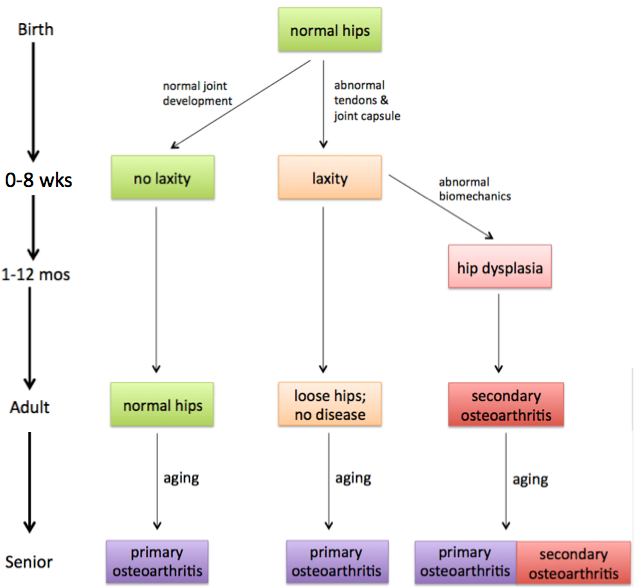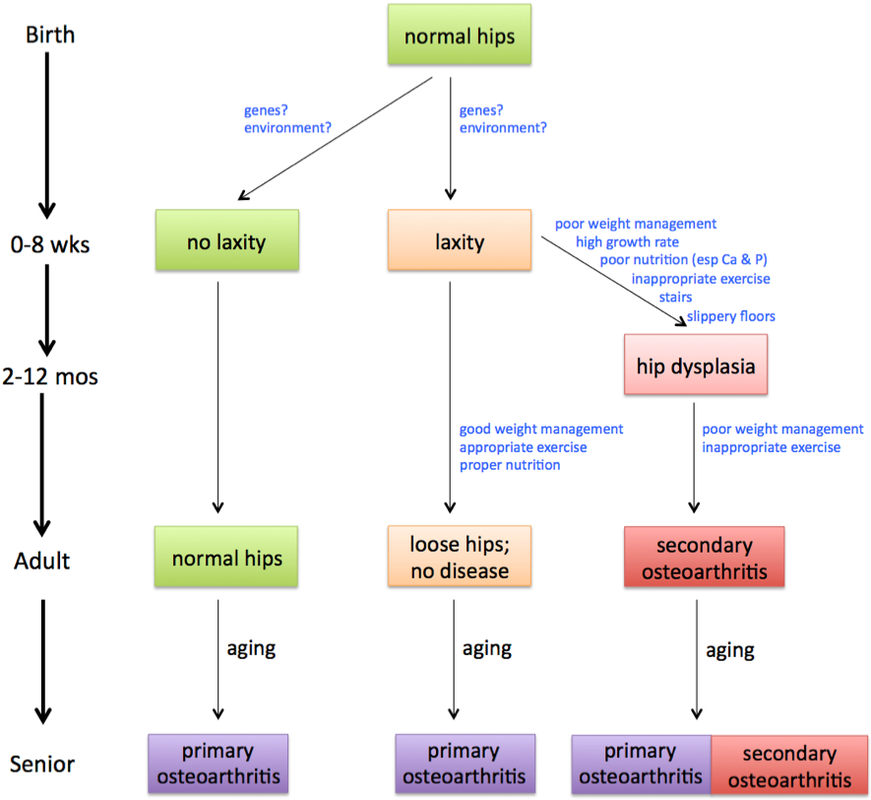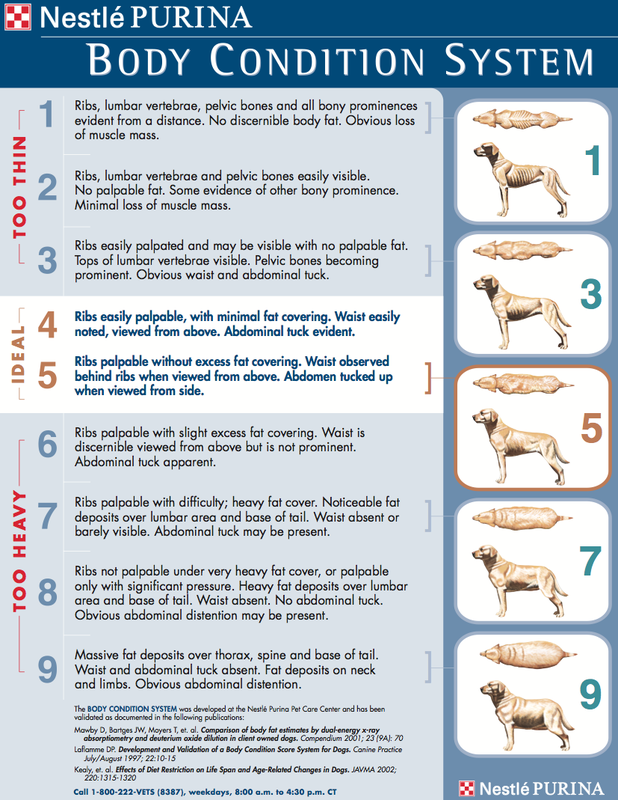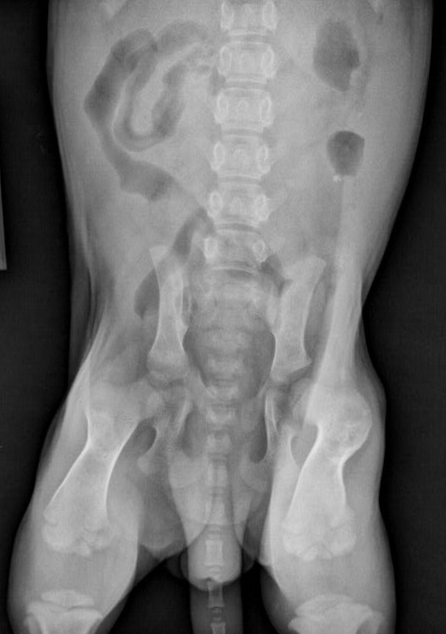We often talk about hip dysplasia as if it is a discrete disorder, and a dog either has it or doesn't. In fact, the word "dysplasia" is a general term in medicine that refers to an abnormality in form or development. In dogs, hip dysplasia is a process with no fixed endpoint. A dog can have "normal" hips (loosely defined), or the hips are not normal and are therefore considered dysplastic, with degrees of variation from slight to severe.
| Puppies with tight hips do not develop hip dysplasia as adults (Riser 1985). On the other hand, some puppies that have hip laxity develop hip dysplasia while others do not, and the reason for this appears to be biomechanics. If the joint is loose, there will be abnormal forces on the femoral head and acetabulum (the socket) when the joint is "loaded"; i.e., when the puppy is standing or moving. These abnormal forces lead to the malformations of the joint and other degenerative changes that are collectively called hip dysplasia. The trauma to the developing joint tissues also unleashes a cascade of biochemical and inflammatory processes that further degrade the hip joint and can become a vicious cycle of deterioration. |
But we also know that there are other non-genetic factors that can also affect whether the developing hip joint will be normal or dysplastic.
Although we don't yet know how to prevent the development of joint laxity, we do know about some of the factors we can control that will affect the risk of developingof hip dysplasia. If we add them to the map of potential paths hip development can take over the life of a dog, we can see where we might intervene to change the course or the severity of developmental dysplasia. Instead of doing a breeding then crossing your fingers for the next 12 or 24 months, waiting for a dog to be old enough for a hip evaluation, the breeder can play a critical role in making sure their careful breeding selection isn't foiled by failure to control the environmental factors that we know can have a large effect on hip development.
These are things a new puppy owner needs to be educated about. Puppies seem tough and resilient, but an x-ray clearly reveals the immaturity of the skeleton. This image of a 2 month old Bernese Mountain Dog shows the locations of cartilage as open gaps between bones because the joints have not yet ossified. The skeleton will not reach adult size until the puppy is 5 or 6 months old (older for large breeds), and it will not be fully ossified until the puppy about 1 a year old.
| The new puppy owner takes over management at a critical time in skeletal development, and many probably don't realize this judging by the number of YouTube videos of puppies falling down stairs, being dropped by little children, feasting on ice cream and fatty beef bones, and skidding across the wood floor to slam into the living room wall. Along with the instructions for feeding, every puppy should go home with a clear list of what it should and should not be doing and at what age. Probably the single most significant risk for development of hip dysplasia is body weight. I have talked elsewhere about the studies that clearly show that food consumption during puppyhood can make the difference between a life free of joint disease into old age, or the development of painful dysplasia as a puppy. The gold standard for managing body weight in both adult dogs and puppies is the Body Condition System (BCS) devised by Purina, which provides both descriptions and illustrations depicting the continuum of body condition from emaciation to obesity. (Click on the illustration to download a copy.) | There's just nothing like a fat, roly-poly puppy with a sweet expression to melt the heart, but every one of those extra pounds increases the magnitude of the abnormal biomechanical forces on the hips (and elbows, too), doing damage that will last a lifetime. And don't forget that an extra pound standing is multiplied when the puppy is in motion, increasing the forces on the hip in proportion to speed, both horizontally and vertically. (If you're not sure how this works, drop an egg on the table from one inch then again from 12 inches high.) Keeping the growing puppy lean (at 4 or 5 on the BCS chart) will go a long way to prevent or at least limit the severity of dysplastic hips. We still have a lot to learn about hip dysplasia, but we do know that there are environmental factors that affect risk. Breeders who help their new puppy owners understand what these are and why they're important will protect the investment in time and effort they have made to produce puppies that will live long, happy lives. |
- Riser WH, WH Rhodes, & CD Newton. 1985. Hip Dysplasia. Ch 83 in Textbook of Small Animal Orthopedics, CD Newton & DM Nunamaker, Eds.
- There is much more to learn about hip dysplasia in ICB's online course Understanding Hip & Elbow Dysplasia that starts 4 January 2016.
Join our Citizen Science Project
ICB is organizing a Citizen Science project to study hip dysplasia in dogs. If you're planning on having a litter of puppies in the near future, you can join us! We will be recording the weight of the puppies, how much they eat, how fast they grow, and a few other things might provide the information we need to figure out how to reduce or even eliminate hip dysplasia in dogs. We will need a lot of data for many different breeds, both large and small, so we need your help!
We will need all of the study participants to be up to speed on what is already known about hip dysplasia from previous studies. To do this, we have organized a course that all of the participants need to enroll in calledUnderstanding Hip & Elbow Dysplasia. The course starts on 4 January 2016 and will last about 10 weeks.
You will learn about anatomy, development, genetics, biomechanics, and much more to lay the foundation for the project. After the course is over we will continue working with those participating in the study to organize the protocol for data collection.
The course is open to everyone whether you are participating in the study or not.
You can register from the "Courses" tab on the ICB website.
We hope to see you there!
ICB's online courses
*******************
Understanding Hip & Elbow Dysplasia
Next class starts
4 January 2016
Managing Genetics for the Future
Next class starts
18 January 2016
Sign up now!
***************************************
Visit our Facebook Groups
ICB Institute of Canine Biology
...the latest canine news and research
ICB Breeding for the Future
...the science of dog breeding






